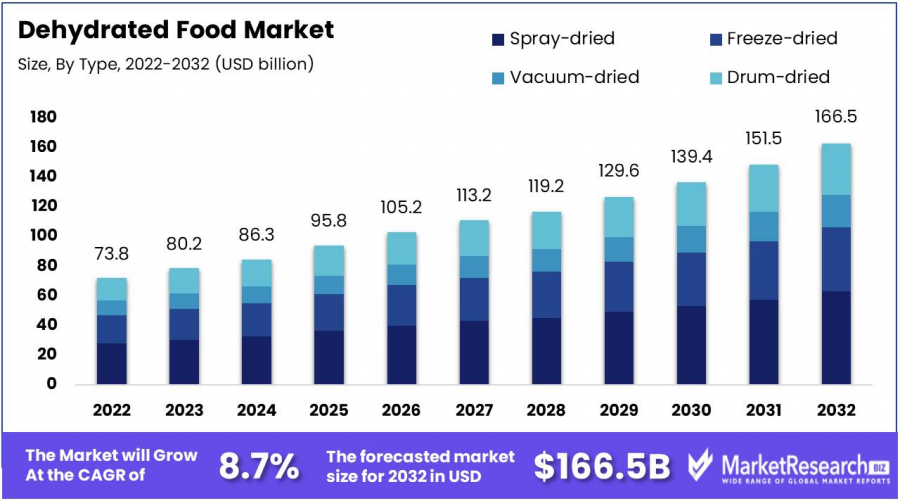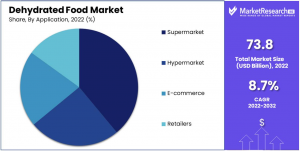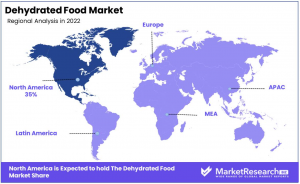
Dehydrated Food Market to Reach USD 166.5 Billion by 2032, Growing at 8.7% CAGR from 2023 to 2032
The Dehydrated Food Market size is expected to be worth around USD 166.5 Bn by 2032 from USD 73.8 Bn in 2022, growing at a CAGR of 8.7%
NEW YORK, NY, UNITED STATES, February 10, 2025 /EINPresswire.com/ -- Overview
The dehydrated food market is rapidly expanding, projected to grow from USD 73.8 billion in 2022 to approximately USD 166.5 billion by 2032 at a CAGR of 8.7%. This surge is driven by consumers' increasing preference for healthy, protein-rich diets and the demand for food products with extended shelf life. Dehydrated foods, through various methods like freeze-drying and spray-drying, offer the advantage of retaining essential nutrients while being lightweight and easy to store. These products are particularly appealing in the current global climate, where logistics disruptions underline the necessity for long-lasting and non-perishable food options.
The market is being bolstered by changing consumer habits towards plant-based and organic food options, as well as a growing trend of outdoor activities such as camping and hiking, which heighten the demand for convenient, packaged foods. Additionally, advances in technology enable better preservation methods, while the distribution landscape is being transformed by e-commerce's rise and its capability for direct-to-consumer sales, offering consumers greater convenience. Supermarkets and online platforms stand as the main retail channels, supporting the market's accessibility and growth. These dynamics collectively shape a vibrant landscape for continued market expansion in the upcoming years.
👉 Request a free sample PDF report for valuable insights: https://marketresearch.biz/report/dehydrated-food-market/request-sample/
Experts Review
Experts highlight several factors influencing the dehydrated food market's growth. Government incentives aimed at promoting sustainable agricultural practices and food processing technologies have accelerated the adoption of advanced dehydration techniques. Technological innovations, such as improved freeze-drying processes, play a crucial role in maintaining product quality, driving market expansion. However, alongside these opportunities are considerable risks, including dependency on raw material supply and the variable effects of climate change on agricultural productivity.
Investment opportunities abound, particularly in the burgeoning segments of plant-based dehydrated foods and health-conscious snacks. Nevertheless, risks include fluctuating raw material costs and changing consumer tastes. Consumer awareness has steadily increased, with a heightened focus on nutrition and sustainability, thereby propelling the demand for dehydrated foods perceived as both healthful and environmentally friendly.
Regulatory environments are generally supportive, with robust frameworks ensuring quality and safety standards, though they vary significantly across regions. The technological impact is profound, as innovations enhance efficiency and output, reducing costs and expanding market reach. Collectively, these elements underscore the market’s complex dynamics, presenting both significant growth potentials and challenges that stakeholders must strategically navigate.
Report Segmentation
The dehydrated food market is segmented based on type, application, product type, and end-user categories, creating a comprehensive structure for analysis.
By Type, the market includes spray-dried, freeze-dried, vacuum-dried, and drum-dried foods. Spray drying is favored for its efficiency across large-scale applications, particularly in coffee and dairy products, while freeze-drying is valued for nutrient retention, especially in fruits and premium items.
By Application, the primary segments are supermarkets, hypermarkets, e-commerce platforms, and other retailers. Supermarkets dominate due to their wide variety of accessible products in one location. Meanwhile, e-commerce is expanding rapidly, facilitating consumer preference for home delivery and online shopping ease.
By Product Type, categories include dehydrated meat and seafood, fruits, vegetables, and ready-to-eat meals. Meat and seafood lead this segment due to their convenient protein source appeal, essential for both individual consumers and applications like camping and emergency supplies.
By End-User, individual consumers and food service establishments represent the primary market segments. Individual consumers drive demand for convenience and shelf-stability, whereas foodservice establishments prioritize bulk purchasing for consistent supply and storage ease. This segmentation reflects the diverse applications and consumer base fueling the market's rapid growth.
Key Market Segments
By Type
• Spray-dried
• Freeze-dried
• Vacuum-dried
• Drum-dried
By Application
• Supermarket
• Hypermarket
• E-commerce
• Retailers
By Product Type
• Dehydrated Meat and Seafood
• Dehydrated Fruits
• Dehydrated Vegetables
• Dehydrated Ready-to-Eat Meals, and Others
By End-User
• Individuals
• Foodservice Establishments
👉 Buy Now to access the full report: https://marketresearch.biz/purchase-report/?report_id=12425
Drivers, Restraints, Challenges, and Opportunities
Drivers of the dehydrated food market include the extended shelf life and nutrient retention of products, aligning with consumer needs for convenience and long-lasting food supplies, especially during supply chain disruptions. Additionally, the cost-effectiveness of home dehydration and the rising demand for healthy, convenient snacks propels market growth.
Restraints involve health concerns over high sodium content in some dehydrated foods, hindering market expansion as consumers pivot towards low-sodium alternatives. Dependence on favorable weather conditions for raw material yield also poses significant market constraints.
Challenges include sourcing high-quality produce amidst agricultural disruptions, which can increase costs and affect product consistency. Navigating these issues while maintaining supply chain resilience and meeting changing consumer demands remains complex.
Opportunities arise from the growing popularity of dehydrated vegetables in the snack sector, reflecting a broader trend towards nutritious, on-the-go food options. This creates avenues for product innovation and diversification, catering to an ever-expanding demand for convenient health foods.
Key Player Analysis
Key players in the dehydrated food market employ strategic innovations to maintain competitive advantage and foster growth. Leading companies such as Van Drunen Farms and European Freeze Dry leverage advanced freeze-drying technologies to offer extensive product ranges. These firms cater to a diverse market, extending from consumer snacks to staple food ingredients.
Diverse market contributions from companies like Mercer Foods, LLC, and Tong Garden Co. Ltd enhance the variety of available dehydrated products, benefiting both retail and industrial segments. Additionally, brands such as Green Rootz focus on specialized market segments, offering niche products of high quality.
ITC Limited and California Sun Dry Foods, with their strong regional presence, effectively utilize expansive distribution networks to maintain market influence. Collectively, these players drive market dynamics through continuous product development, technological advancement, and strategic regional expansions, ensuring sustainable sector growth.
Top Key Players in the Dehydrated Food Market
• Van Drunen Farms
• European Freeze Dry
• Mercer Foods, LLC
• Tong Garden Co. Ltd.
• Crispy Green Inc.
• Dried Processed Food
• Dried Fruit & Vegetable
• Dried Dairy
• Dried Meat & Seafood
• Harmony House Foods Inc.
• Mother Earth Products
• Green Rootz
• ITC Limited (India)
• California Sun Dry Foods (U.S.)
• BCFoods, Inc. (U.S.)
• Bella Sun Luci (U.S.)
• Mondelez International, Inc. (U.S.)
• Sensient Technologies Corporation (U.S.)
• Lion Raisins Inc.
• Viva Bella Orchards Inc.
• Sow Good Inc.
Recent Developments
Recent developments in the dehydrated food market underline significant strategic expansions and product innovations. In 2022, General Mills extended its "Food Should Taste Good" product line, introducing organic vegetable chip varieties, aligning with health-focused consumer trends.
In 2021, Nestle diversified its product offerings under the Maggi brand by launching dehydrated meat pieces, enhancing its appeal to health-conscious consumers looking for nutritious and convenient cooking solutions.
Oregon Freeze Dry, in 2020, enhanced its production facilities to cater to the growing demand for freeze-dried meals and ingredients, showcasing proactive capacity expansion in response to market needs.
Kerry Group's 2019 acquisition of Southeastern Mills' dehydrated vegetable business exemplifies strategic growth to broaden its portfolio in food ingredients. These developments highlight the industry's dynamic nature and its capacity for adaptive growth in response to evolving consumer demands and market conditions.
Conclusion
The dehydrated food market is poised for substantial growth, driven by consumer demand for long-lasting, convenient food options. Technological advancements and shifts towards health-conscious purchasing behavior further support this trajectory. However, maintaining balance in product quality amidst raw material and supply chain challenges will be crucial. As key players continue to innovate and adapt to varying consumer preferences, the market is expected to witness sustained expansion and diversification. The strategic efforts of these companies will be instrumental in navigating market dynamics and capitalizing on emerging opportunities.
Lawrence John
Prudour
+91 91308 55334
Lawrence@prudour.com
Visit us on social media:
Facebook
LinkedIn
Distribution channels: Food & Beverage Industry
Legal Disclaimer:
EIN Presswire provides this news content "as is" without warranty of any kind. We do not accept any responsibility or liability for the accuracy, content, images, videos, licenses, completeness, legality, or reliability of the information contained in this article. If you have any complaints or copyright issues related to this article, kindly contact the author above.
Submit your press release


